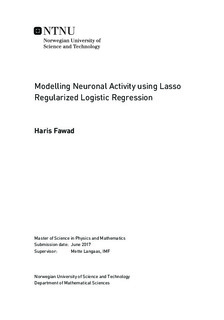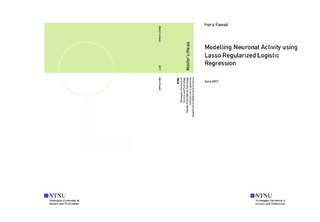| dc.description.abstract | Studies have shown that neurons in a mouse's anterior lateral motor cortex (ALM), which is a part of the brain related to the planning and the execution of tongue movements, predict certain movements second before they occur. This raises the question: how does this so-called preparatory activity in the ALM translate into commands in other motor-related parts of the brain that eventually trigger a body movement? To investigate this, we fit lasso penalized logistic regression models that relate the activity of a neuron to the activity of all other neurons (in the data set). In addition, the regression models include the effect of a certain type of stimulus that is given to the mouse as part of the experiment in which the data is collected. The estimated regression parameters are then used to estimate a network of neurons that shows how the neurons are connected to each other, and hence in effect, visualize the underlying information flow in the ALM. Additionally, the estimated parameters also show the so-called tuning of a neuron, that is, the relation between the activity of a neuron and the given stimulus.
The analyses were based on the so-called alm-1 data set, which contains extracellular recordings of neurons of 19 adult mice. The lasso penalized logistic regression models were fit to data from a single mouse, which revealed that each neuron is seemingly tuned to a different stimuli. Additionally, in the estimated network of neurons, constructed by evaluating (family-wise error rate) adjusted p-values controlled at significance level 5 %, the so-called fast spiking (FS) neurons seem to be a central part of the underlying network, as these neurons have the highest amount of connections compared to so-called pyramidial neurons. | |

